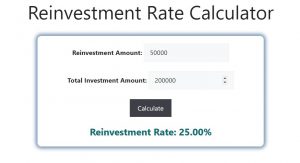About Reinvestment Rate Calculator (Formula)
The reinvestment rate is a crucial metric for businesses looking to gauge how effectively they are utilizing their profits for growth and expansion. By understanding the proportion of profits that are reinvested back into the company, stakeholders can make informed decisions about future investments and strategic planning. The Reinvestment Rate Calculator helps businesses quantify this metric, allowing for a clearer understanding of their reinvestment strategies. This article will cover how to use the calculator, provide examples, and address common questions regarding the reinvestment rate.
Formula
The formula for calculating the reinvestment rate is:
Reinvestment Rate = (Reinvestment Amount / Total Investment Amount) * 100
This formula yields a percentage that reflects how much of the total investment amount is being reinvested in the business.
How to Use
Using the Reinvestment Rate Calculator is simple:
- Determine the Reinvestment Amount: Identify the amount of profits or funds that you plan to reinvest into the business.
- Determine the Total Investment Amount: Calculate the total amount of capital that has been invested in the business, including both initial and ongoing investments.
- Apply the Formula: Insert your values into the formula to calculate the reinvestment rate.
- Analyze the Results: The resulting percentage will indicate the level of reinvestment relative to the total investment, providing insights into your business strategy.
Example
For instance, let’s say a company decides to reinvest $50,000 of its profits into the business, and the total investment amount is $200,000.
Using the formula:
Reinvestment Rate = (50,000 / 200,000) * 100 = 25%
In this example, the reinvestment rate is 25%, meaning that 25% of the total investment amount is being reinvested back into the business.

FAQs
- What is the reinvestment rate?
The reinvestment rate measures the percentage of profits or funds reinvested back into a business relative to the total investment amount. - Why is the reinvestment rate important?
It provides insights into a company’s growth strategy and how effectively profits are being utilized for expansion. - How can I improve my reinvestment rate?
By prioritizing growth opportunities, cutting unnecessary expenses, and strategically allocating profits toward high-impact investments. - What constitutes the reinvestment amount?
The reinvestment amount includes profits, retained earnings, or any funds designated for business development. - What factors can influence the reinvestment rate?
Market conditions, business goals, operational efficiency, and cash flow can all impact the reinvestment rate. - How often should I calculate the reinvestment rate?
It’s beneficial to calculate the reinvestment rate annually or quarterly to assess business performance and strategy. - Can a high reinvestment rate be a negative sign?
Not necessarily, but it may indicate that a company is not distributing dividends or managing profits effectively. - How does the reinvestment rate relate to company growth?
A higher reinvestment rate typically signifies a focus on growth, while a lower rate might indicate a more conservative or profit-sharing approach. - Is the reinvestment rate the same as the retention ratio?
While similar, the retention ratio specifically refers to the portion of earnings retained rather than distributed, while the reinvestment rate includes all reinvested funds. - How can investors use the reinvestment rate?
Investors can assess a company’s growth potential and strategic focus by evaluating its reinvestment rate. - What is a good reinvestment rate?
A “good” reinvestment rate varies by industry; however, rates between 20% to 50% are often considered healthy for growth-focused companies. - Can a company sustain a high reinvestment rate long-term?
Yes, if managed well, but companies should also balance reinvestment with shareholder returns to maintain investor confidence. - What role do external factors play in reinvestment rates?
Economic conditions, regulatory changes, and competition can all influence a company’s ability and decision to reinvest profits. - How does debt impact the reinvestment rate?
High levels of debt can limit the ability to reinvest, as more profits may need to be allocated toward interest payments. - What is the relationship between the reinvestment rate and ROI?
A higher reinvestment rate can lead to a higher ROI if the reinvested funds generate significant returns. - Can the reinvestment rate fluctuate over time?
Yes, it can change based on the company’s financial performance, market conditions, and strategic shifts. - How can companies communicate their reinvestment strategy to stakeholders?
Through regular reports, investor meetings, and transparency in financial statements highlighting reinvestment activities. - What happens if a company fails to reinvest?
A lack of reinvestment can hinder growth, innovation, and competitiveness, potentially leading to decline over time. - Are there industry benchmarks for reinvestment rates?
Yes, industry averages can provide context for evaluating a company’s reinvestment rate against peers. - How do reinvestment rates affect company valuations?
Higher reinvestment rates can indicate growth potential, which may positively influence valuations by investors.
Conclusion
The Reinvestment Rate Calculator serves as a vital tool for businesses aiming to optimize their growth strategies. By understanding and calculating the reinvestment rate, companies can gain insights into how effectively they are utilizing their profits to fuel expansion and improve overall performance. Regularly assessing the reinvestment rate helps organizations make informed decisions, align their strategies with market conditions, and ultimately achieve sustainable growth.